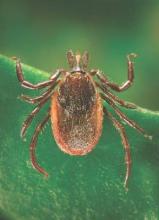Long-term is no better than standard antibiotic therapy for persistent symptoms of Lyme disease, according to a report published online March 30 in the New England Journal of Medicine.
Randomized clinical trials have never shown convincingly that prolonged antibiotic therapy is beneficial for the many patients with Lyme disease who have persistent debilitating symptoms such as musculoskeletal pain, arthritis, arthralgia, neuralgia, sensory disturbances, dysesthesia, neuropsychological disorders, cognitive disorders, and fatigue. But some less rigorous studies have reported beneficial effects with prolonged antibiotics, and some guidelines endorse that approach, said Dr. Anneleen Berende of the Center for Infectious Diseases at Radboud University Medical Center, Nijmegen, the Netherlands, and her associates.
They performed a randomized, double-blind clinical trial, the Persistent Lyme Empiric Antibiotic Study Europe (PLEASE), in which 280 adults (mean age, 49 years) received daily 2,000-mg open-label IV ceftriaxone for 14 days and then were assigned to receive 100 mg oral doxycycline twice daily plus placebo (86 patients), combined 500 mg clarithromycin twice daily plus 200 mg hydroxychloroquine twice daily (96 patients), or two placebo capsules twice daily (98 patients) for 12 weeks. Patients were eligible for the trial if their persistent symptoms were temporally related to an erythema migrans rash or an otherwise proven case of symptomatic Lyme disease or were accompanied by Borrelia burgdorferi IgG or IgM antibodies according to immunoblot assay. They had median durations of symptoms of 2.1-2.7 years. Symptoms were assessed by self-report using the RAND SF-36 Health Status Inventory at baseline, at the end of the 14-week treatment period, and at 26, 40, and 52 weeks.
In the intention-to-treat analysis, the primary outcome measure – health-related quality of life as assessed on the physical component summary score of the RAND SF-36 at 14 weeks – did not differ significantly among the three study groups. The mean physical component summary scores were 35.0 with doxycycline, 35.6 with clarithromycin/hydroxychloroquine, and 34.8 with placebo. In addition, none of the secondary outcome measures, including mental impairment and fatigue, differed significantly among the three study groups, either at the end of treatment or at any subsequent follow-up visit.
The results of all sensitivity analyses, including the per-protocol analysis restricted to the 212 patients most adherent to the study regimen, accorded with those of the main analysis, Dr. Berende and her associates said (N Engl J Med. 2016;374[13]:1209-20).
“At the 14-week visit at the end of the treatment period, the mean SF-36 physical component summary score had improved significantly from baseline regardless of the study group assignment, but quality of life remained below that of the general population,” they noted.
Nearly three-fourths of patients reported at least one adverse event of a given type during the open-label and randomized phases combined, and approximately half reported adverse events during the randomized phase without any significant difference in rate across the groups. Patients taking doxycycline reported photosensitivity and nausea most often, and patients taking clarithromycin-hydroxychloroquine reported nausea, diarrhea, and rash most often. Fourteen patients (5.0%) discontinued the intervention because of adverse effects, and the number was similar across the three study groups.
This study was supported by the Netherlands Organization for Health Research and Development (ZonMw). Dr. Berende reported having no relevant financial disclosures; one of her associates reported inventing a patented cellular diagnostic test for Lyme disease.


